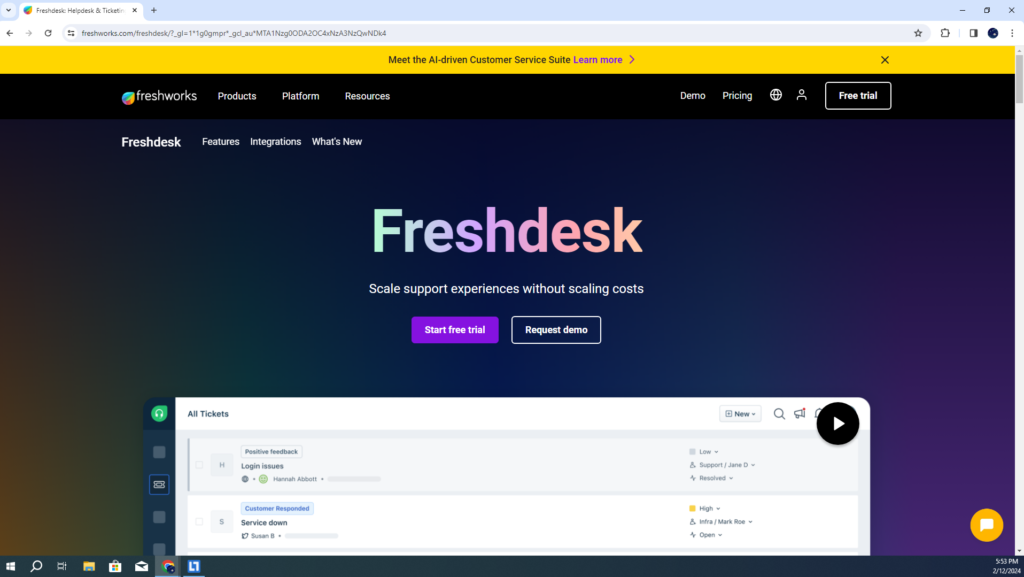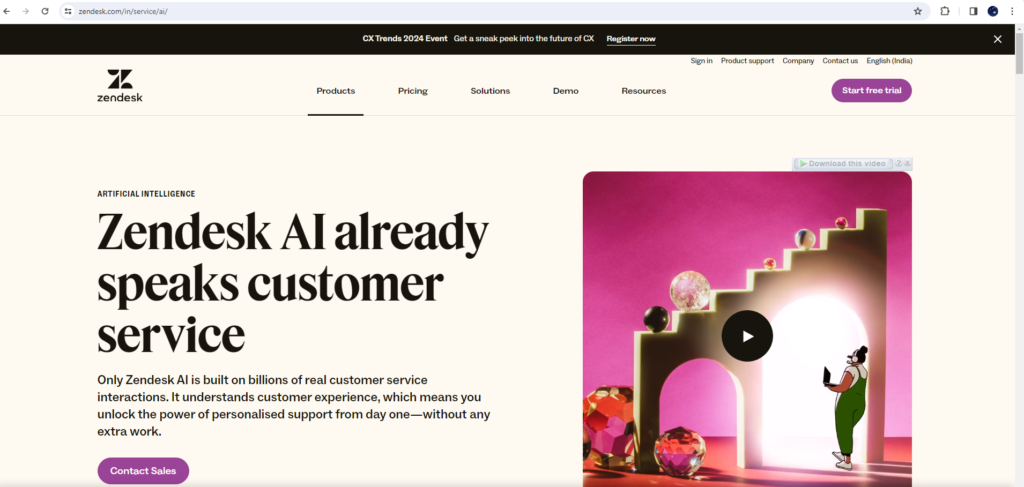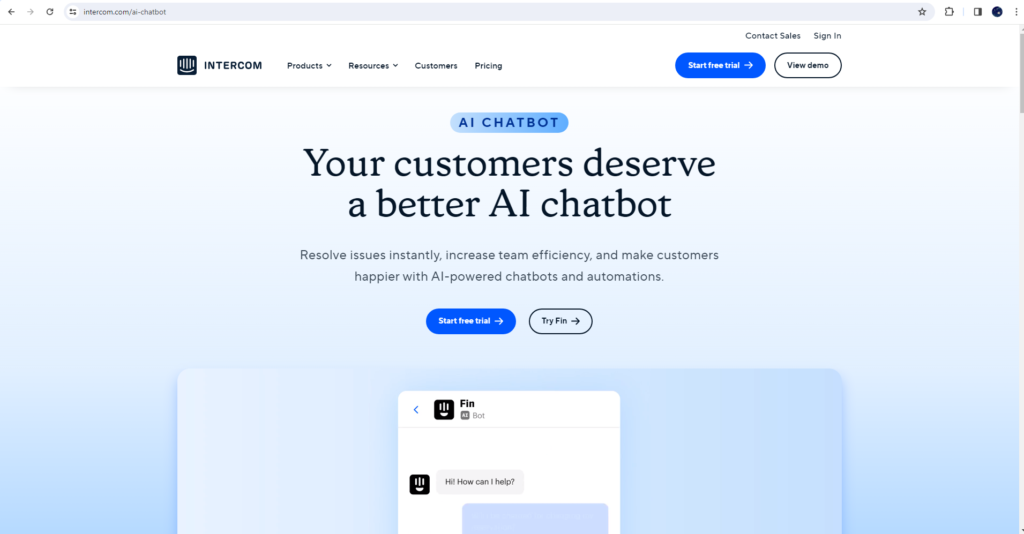Struggling with overloaded support and lagging response times? Discover the top 5 AI tools for customer service automation, designed to streamline workflows, empower agents, and delight customers.
Unleash the power of AI to supercharge your customer service! This guide explores the top 5 AI tools that automate tasks, personalize interactions, and optimize agent performance. Reduce ticket volume, boost efficiency, and elevate customer satisfaction – all with the right AI partner. Discover features, strengths, and considerations to find the perfect fit for your business. Start improving your customer experience today!
1.Freshdesk Freddy

Freshdesk Freddy is an advanced customer support solution that offers a range of benefits for businesses looking to provide top-notch service to their customers. Here’s a more detailed exploration of its pros and cons:
Pros:
- Omnichannel Support: Freshdesk Freddy enables businesses to provide support across various channels, including email, chat, phone, social media, and more. This ensures that customers can reach out using their preferred communication method, leading to enhanced customer satisfaction and engagement.
- AI-Powered Agent Assist: One of the standout features of Freshdesk Freddy is its AI-powered agent assist functionality. This feature suggests replies to agents based on the context of the customer query, helping them resolve tickets more efficiently and effectively. It also reduces agent workload by automating repetitive tasks.
- Customer Sentiment Analysis: With Freshdesk Freddy, businesses can analyze customer sentiment to gain insights into how customers feel about their products or services. By understanding customer sentiment, companies can identify areas for improvement and take proactive measures to address customer concerns, ultimately enhancing customer loyalty and retention.
- Churn Prediction: Freshdesk Freddy utilizes AI algorithms to predict customer churn, enabling businesses to identify at-risk customers and take preemptive actions to prevent them from churning. This proactive approach to customer retention can help businesses maintain long-term customer relationships and drive revenue growth.
Cons:
- Less Suitable for Simple Needs: While Freshdesk Freddy offers a wide range of advanced features, it may be perceived as overly complex or feature-rich for businesses with simpler support requirements. Smaller companies or those with basic support needs may find that they don’t fully utilize or require all of Freshdesk Freddy’s capabilities.
- Budget Considerations: As a comprehensive customer support solution with advanced AI capabilities, Freshdesk Freddy may come with a higher price tag compared to simpler or more basic support tools. For budget-conscious companies, the cost of implementing Freshdesk Freddy may be prohibitive, especially if they don’t fully leverage its advanced features.
Freshdesk Freddy is a powerful customer support solution that offers omnichannel support, AI-powered assistance, sentiment analysis, and churn prediction capabilities. While it may be less suitable for simpler needs or budget-conscious companies, its advanced features make it an excellent choice for businesses looking to provide exceptional customer service and drive long-term customer loyalty.
2. Zendesk AI

Zendesk AI offers a range of benefits and drawbacks, making it a versatile tool for businesses seeking to enhance their customer support operations. Here are some additional points to consider:
Pros:
- Enhanced Efficiency: Zendesk AI streamlines customer service processes by automating message analysis and providing reply suggestions. This can significantly reduce response times and workload for support agents, leading to higher productivity and customer satisfaction.
- Seamless Integration: As Zendesk AI is integrated within the Zendesk platform, it seamlessly aligns with existing workflows and systems. This integration ensures a smooth transition for businesses already using Zendesk for their customer support needs.
- Personalized Customer Interactions: The AI-powered chatbot integration enables businesses to deliver personalized and timely responses to customer inquiries. By understanding customer preferences and historical interactions, the chatbot can provide tailored assistance, enhancing the overall customer experience.
- Proactive Issue Resolution: Through process gap identification, Zendesk AI helps businesses identify areas for improvement in their support processes. By addressing these gaps proactively, organizations can enhance operational efficiency and prevent potential customer issues from escalating.
Cons:
- Dependency on Zendesk Subscription: One of the primary drawbacks of Zendesk AI is its requirement for an existing Zendesk subscription. This dependency may limit accessibility for businesses that do not currently use Zendesk or are exploring alternative customer support solutions.
- Limited Standalone Functionality: While Zendesk AI offers robust features within the Zendesk platform, its standalone functionality may be limited compared to dedicated AI customer support solutions. Businesses seeking standalone AI capabilities may need to explore other options to meet their specific requirements.
- Learning Curve: Implementing and optimizing Zendesk AI may require time and resources to train staff and customize the platform to suit the organization’s needs. Businesses should be prepared to invest in training and support to maximize the benefits of Zendesk AI effectively.
- Integration Complexity: While Zendesk AI seamlessly integrates with Zendesk’s ecosystem, integrating with other third-party systems or platforms may pose challenges. Businesses with complex IT environments may encounter integration issues that require additional effort to resolve.
3. Help Scout

Help Scout is a user-friendly customer support platform designed to streamline communication between businesses and their customers. With features such as email ticket automation, built-in chatbots, and customizable reporting, Help Scout aims to enhance customer service efficiency and satisfaction.
Pros:
- User-Friendly Interface: Help Scout offers an intuitive and easy-to-navigate interface, making it simple for support agents to manage customer inquiries effectively.
- Email Ticket Automation: Businesses can automate repetitive tasks and streamline their support process by setting up rules and workflows for email ticket management.
- Built-in Chatbot: Help Scout includes a built-in chatbot feature that allows businesses to provide immediate assistance to customers on their website or other digital channels.
- Customizable Reporting and Analytics: Help Scout provides robust reporting and analytics tools, allowing businesses to gain insights into their support performance and customer behavior. Users can customize reports to track key metrics and identify areas for improvement.
Cons:
- Limited Advanced Features: While Help Scout offers essential customer support functionalities, it may lack advanced features like sentiment analysis or churn prediction, which are available in some competing platforms.
- Integration Limitations: Although Help Scout supports integration with various third-party tools and platforms, it may not offer as extensive integration options as some other customer support solutions.
- Scalability Challenges: Some businesses may find Help Scout less suitable for scaling their customer support operations, particularly if they require advanced automation or customization beyond Help Scout’s capabilities.
- Cost Considerations: Depending on the specific needs of a business, the pricing structure of Help Scout may not be the most cost-effective option compared to other alternatives in the market.
4.HubSpot Service Hub

HubSpot Service Hub incorporates some elements of artificial intelligence (AI) in its features and functionality. For example:
- Chatbots: Service Hub includes chatbots that can use natural language processing (NLP) and machine learning algorithms to understand customer inquiries and provide relevant responses.
- Automation: The automation tools within Service Hub utilize AI to streamline processes, such as automatically assigning tickets to the appropriate team based on keywords or customer data.
- Predictive Analytics: Some features may use AI to analyze customer data and predict future behavior or identify trends, helping businesses proactively address customer needs.
While Service Hub leverages AI in certain aspects, it’s not solely driven by AI. It combines AI capabilities with other technologies and tools to provide comprehensive customer service solutions.
5.Intercom

“Intercom’s AI Chatbot, Fin, revolutionizes customer support by delivering instant, personalized assistance 24/7. Powered by advanced artificial intelligence, Fin seamlessly engages with website visitors, addressing common inquiries and guiding users to relevant resources with unparalleled efficiency. With its intuitive conversation flow and natural language processing capabilities, Fin provides a human-like interaction experience, ensuring customers feel heard and valued. From answering FAQs to qualifying leads and even scheduling appointments, Intercom’s AI Chatbot streamlines support workflows, boosts customer satisfaction, and drives business growth. Experience the future of customer engagement with Intercom’s AI Chatbot, empowering your team to deliver exceptional service at scale.”
Pros:
- Proactive Customer Engagement: Intercom allows businesses to engage with customers proactively through targeted messages and campaigns, enhancing customer satisfaction and retention.
- AI-Powered Conversation Summaries: The AI-powered conversation summaries in Intercom help customer support teams quickly understand the context of a conversation, enabling them to provide more efficient and personalized responses.
- Message Drafting Assistance: Intercom’s AI capabilities assist in drafting messages, saving time for support agents and ensuring consistent and effective communication with customers.
- Built-in Chatbot (Fin): The built-in chatbot, Fin, offers automated support and can handle common customer inquiries, freeing up human agents to focus on more complex issues.
- Unified Platform: Intercom provides a unified platform for managing customer interactions across multiple channels, including chat, email, and social media, simplifying customer support operations.
- Rich Customer Data: Intercom collects and provides rich customer data, allowing businesses to gain insights into customer behavior, preferences, and needs, which can inform strategic decision-making and personalized customer interactions.
Cons:
- Primarily for B2B Companies: Intercom’s features and pricing structure may be more tailored towards B2B companies, potentially limiting its suitability for some B2C businesses.
- Pricing Based on Monthly Active Users (MAU): Intercom’s pricing is based on the number of monthly active users, which may result in higher costs for businesses with fluctuating or seasonal user activity.
- Learning Curve: While Intercom offers powerful features, there may be a learning curve for new users to fully leverage its capabilities, particularly for configuring advanced automation and targeting options.
- Integration Complexity: Integrating Intercom with existing systems and workflows may require technical expertise, and ensuring seamless data exchange between Intercom and other platforms can be challenging for some businesses.
- Limited Customization: While Intercom provides a range of customization options, some businesses may find certain aspects of the platform’s functionality or user interface to be less flexible than desired.















